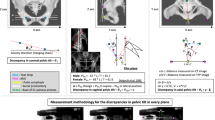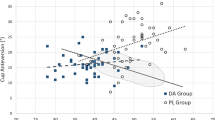Abstract
Introduction
Malpositioning of the cup in total hip arthroplasty (THA) is associated with dislocation, early polyethylene wear, and impingement. The direct anterior approach (DAA) THA allows for intraoperative fluoroscopy imaging (IF). The current study investigates the following research hypotheses: (1) intraoperative measurements of radiographic cup inclination (RI) are reliable and reproducible. (2) A correction factor can compensate for the complex parallax effects when using IF.
Methods
In 2016, 100 consecutive hips underwent primary THA utilizing DAA and IF for cup placement. RI was measured on intraoperative fluoroscopy images and postoperative AP pelvis radiographs.
Results
Determination of RI on IF images is reliable and reproducible (ICC 0.851–0.950). RI measurement on IF images had a good correlation with the corresponding postoperative RI on AP pelvis radiographs (r = 0.538, p < 0.001). However, intraoperative RI measurements are on average 4.9° lower compared to postoperative measurements (SD 2.5°).
Conclusion
Intraoperative fluoroscopy is a reliable tool to measure RI during DAA THA. The surgeon needs to apply a 5°. correction factor to the intraoperative measurements to adjust for parallax.





Similar content being viewed by others
References
Boettner F, Zingg M, Emara AK, Waldstein W, Faschingbauer M, Kasparek MF (2016) The accuracy of acetabular component position using a novel method to determine anteversion. J Arthroplast 32(4): 1180–1185
Chan YH (2003) Biostatistics 104: correlational analysis. Singap Med J 44(12):614–619
Cohen J (1988) Statistical power analysis for the behavioral sciences. L. Erlbaum Associates, Hillsdale
Craiovan B, Weber M, Worlicek M et al (2016) Measuring acetabular cup orientation on Antero-Posterior radiographs of the hip after total hip arthroplasty with a vector arithmetic radiological method. Is it valid and verified for daily clinical practice? Rofo 188(6):574–581
Derbyshire B (2008) Correction of acetabular cup orientation measurements for X-ray beam offset. Med Eng Phys 30(9):1119–1126
Dora C, Houweling M, Koch P, Sierra RJ (2007) Iliopsoas impingement after total hip replacement: the results of non-operative management, tenotomy or acetabular revision. J Bone Jt Surg Brit Vol 89(8):1031–1035
Falliner A, Muhle C, Brossmann J (2002) Acetabular inclination and anteversion in infants using 3D MR imaging. Acta Radiologica, 43(2):221–224 (Stockholm, Sweden: 1987)
Faul F, Erdfelder E, Buchner A, Lang AG (2009) Statistical power analyses using G*Power 3.1: tests for correlation and regression analyses. Behav Res Methods 41(4):1149–1160
Goergen TG, Resnick D (1975) Evaluation of acetabular anteversion following total hip arthroplasty: necessity of proper centring. Br J Radiol 48(568):259–260
Kennedy JG, Rogers WB, Soffe KE, Sullivan RJ, Griffen DG, Sheehan LJ (1998) Effect of acetabular component orientation on recurrent dislocation, pelvic osteolysis, polyethylene wear, and component migration. J Arthroplast 13(5):530–534
Lembeck B, Mueller O, Reize P, Wuelker N (2005) Pelvic tilt makes acetabular cup navigation inaccurate. Acta Orthopaedica 76(4):517–523
Lewinnek GE, Lewis JL, Tarr R, Compere CL, Zimmerman JR (1978) Dislocations after total hip-replacement arthroplasties. J Bone Jt Surg Am Vol 60(2):217–220
Lu M, Zhou YX, Du H, Zhang J, Liu J (2013) Reliability and validity of measuring acetabular component orientation by plain anteroposterior radiographs. Clin Orthop Relat Res 471(9):2987–2994
Maratt JD, Esposito CI, McLawhorn AS, Jerabek SA, Padgett DE, Mayman DJ (2015) Pelvic tilt in patients undergoing total hip arthroplasty: when does it matter? J Arthroplast 30(3):387–391
McArthur B, Cross M, Geatrakas C, Mayman D, Ghelman B (2012) Measuring acetabular component version after THA: CT or plain radiograph? Clin Orthop Relat Res 470(10):2810–2818
Murray DW (1993) The definition and measurement of acetabular orientation. J Bone Jt Surg Brit Vol 75(2):228–232
Ross JR, Tannenbaum EP, Nepple JJ, Kelly BT, Larson CM, Bedi A (2015) Functional acetabular orientation varies between supine and standing radiographs: implications for treatment of femoroacetabular impingement. Clin Orthop Relat Res 473(4):1267–1273
Saxler G, Marx A, Vandevelde D et al (2004) The accuracy of free-hand cup positioning—a CT based measurement of cup placement in 105 total hip arthroplasties. Int Orthop 28(4):198–201
Schrading S, Schulze A (2016) Preoperative diagnostic imaging and planning. Der Orthopade 45(8):644–652
Schwarz T, Weber M, Worner M, Renkawitz T, Grifka J, Craiovan B (2017) Central X-ray beam correction of radiographic acetabular cup measurement after THA: an experimental study. Int J Comput Assist Radiol Surg 12(5):829–837
Tannast M, Murphy SB, Langlotz F, Anderson SE, Siebenrock KA (2006) Estimation of pelvic tilt on anteroposterior X-rays—a comparison of six parameters. Skeletal Radiol 35(3):149–155
Thoren B, Sahlstedt B (1990) Influence of pelvic position on radiographic measurements of the prosthetic acetabular component. An experimental study on a pelvic model. Acta Radiol 31(2):133–136 (Stockholm, Sweden: 1987)
Waldstein W, Merle C, Schmidt-Braekling T, Boettner F (2014) Does stem design influence component positioning in total hip arthroplasty using a minimal invasive posterolateral approach? Int Orthop 38(7):1347–1352
Widmer KH (2004) A simplified method to determine acetabular cup anteversion from plain radiographs. J Arthroplast 19(3):387–390
Author information
Authors and Affiliations
Corresponding author
Ethics declarations
Ethical approval
All procedures performed in studies involving human participants were in accordance with the ethical standards of the institutional research committee and with the 1964 Helsinki declaration and its later amendments or comparable ethical standards.
Additional information
Publisher’s Note
Springer Nature remains neutral with regard to jurisdictional claims in published maps and institutional affiliations.
Rights and permissions
About this article
Cite this article
Rueckl, K., Alcaide, D.J., Springer, B. et al. Intraoperative measurement of cup inclination using fluoroscopy requires a correction factor. Arch Orthop Trauma Surg 139, 1511–1517 (2019). https://doi.org/10.1007/s00402-019-03168-w
Received:
Published:
Issue Date:
DOI: https://doi.org/10.1007/s00402-019-03168-w




